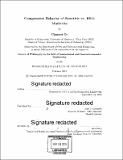Compression behavior of smectitic vs. illitic mudrocks
Author(s)
Ge, Chunwei.
Download1102638220-MIT.pdf (36.31Mb)
Other Contributors
Massachusetts Institute of Technology. Department of Civil and Environmental Engineering.
Advisor
John T. Germaine.
Terms of use
Metadata
Show full item recordAbstract
Overpressure or fluid pressure in excess of hydrostatic pressure has been observed globally in many deep water sedimentary basins. One of the possible mechanisms for overpressure is the smectite-to-illite (S-I) transformation. During the transformation, the basal spacing of the smectite layer reduces. The interlayer water is released into pore space, causing an increase in pore pressure. This thesis investigates the compression and permeability behavior change due to S-I transformation. Uniaxial compression testing was performed on smectitic and illitic mudrocks. The original Gulf of Mexico - Eugene Island (GoM-EI) mudrock sets the baseline for smectitic mudrock in order to compare with illitic mudrocks. Two methods were used to create illitic mudrock from the GoM-EI sediment. The illitic mudrock A was cooked in a high temperature constant rate of strain (CRS) device with effective stress applied (200 °C and 30 days); the illitic mudrock B was cooked in a hydrothermal cooker in a slurry state (250 °C and 18 days). The multi-functional high temperature CRS device was designed from scratch to tackle the challenge of measuring the mechanical properties of a mudrock and transforming the clay minerals. Although the methods of inducing S-I transformation are different, similar degrees of illitization for the illitic mudrock A and B was achieved by selecting the right temperature and time combination. The mineral transformation does not greatly alter the compressibility of the mudrocks. However, both the illitic mudrock A and B sit higher in porosity space than the smectitic mudrock at low stress level. As effective stress increases, the illitic mudrock A converges with the smectitic mudrock, while the illitic mudrock B reverses order with the smectitic mudrock at 30 MPa. The permeability of the smectitic mudrock ranges over five orders from 10⁻¹⁶ to 10⁻²⁰ m² from a porosity of 0.58 to 0.23. The permeability of the mudrocks are greatly increased by the mineral transformation. The permeability ratio of the illitic mudrocks over the smectitic mudrock increases from 2 to 12 as porosity decreases. The creep rate (C[subscript alpha]) at room temperature and elevated temperature were measured during the transformation stage of the illitic mudrock A. C[subscript alpha] at elevated temperature increases by 50 % compared with that at room temperature. The increase in rate is caused by mineral transformation. Using the difference in rate, a model is proposed to estimate the effective stress reduction or overpressure generation based on the degree of mineral transformation.
Description
Thesis: Ph. D. in the field of Geotechnical and Geoenvironmental Engineering, Massachusetts Institute of Technology, Department of Civil and Environmental Engineering, 2019 Cataloged from PDF version of thesis. Includes bibliographical references (pages 165-168).
Date issued
2019Department
Massachusetts Institute of Technology. Department of Civil and Environmental EngineeringPublisher
Massachusetts Institute of Technology
Keywords
Civil and Environmental Engineering.